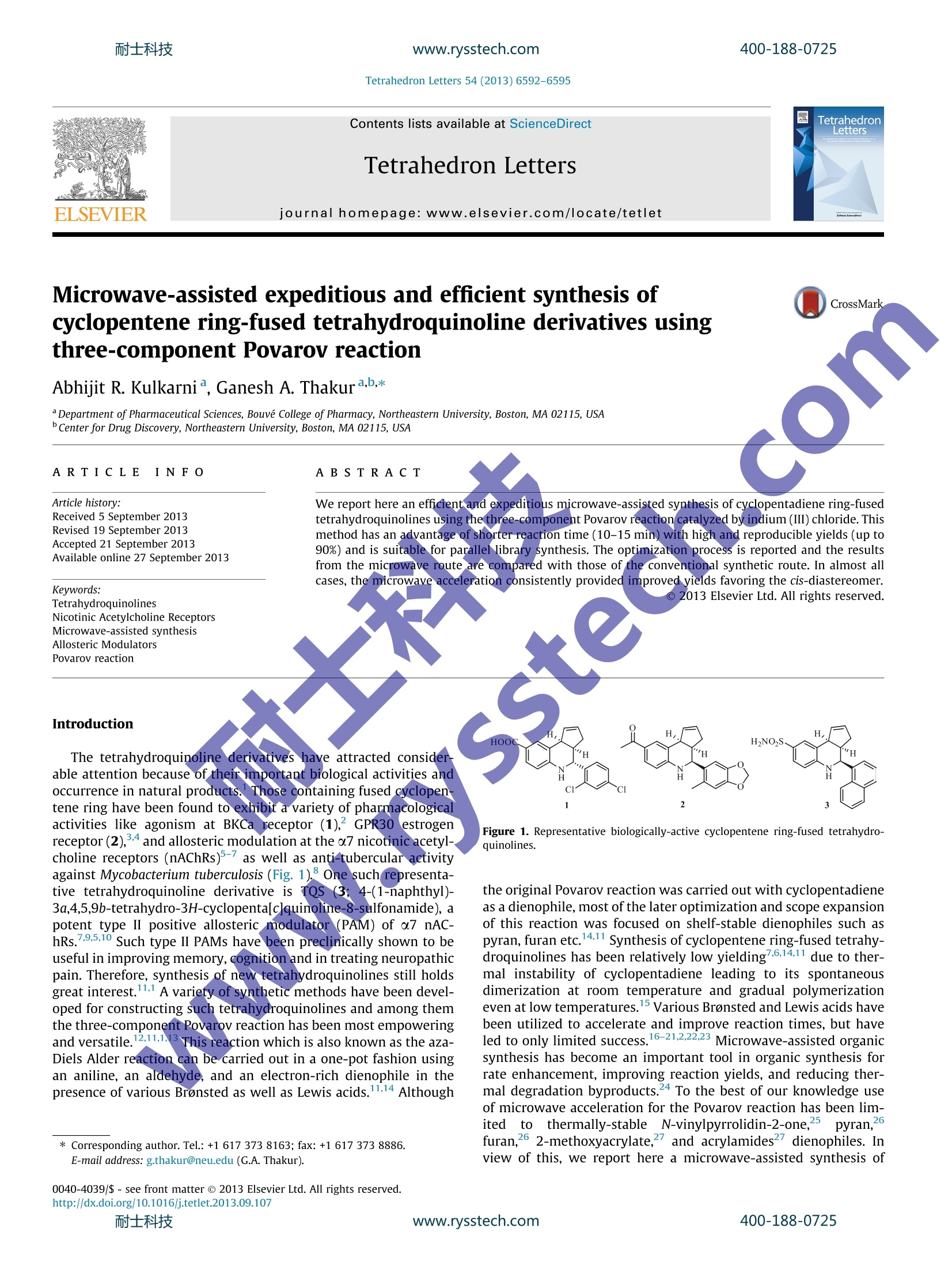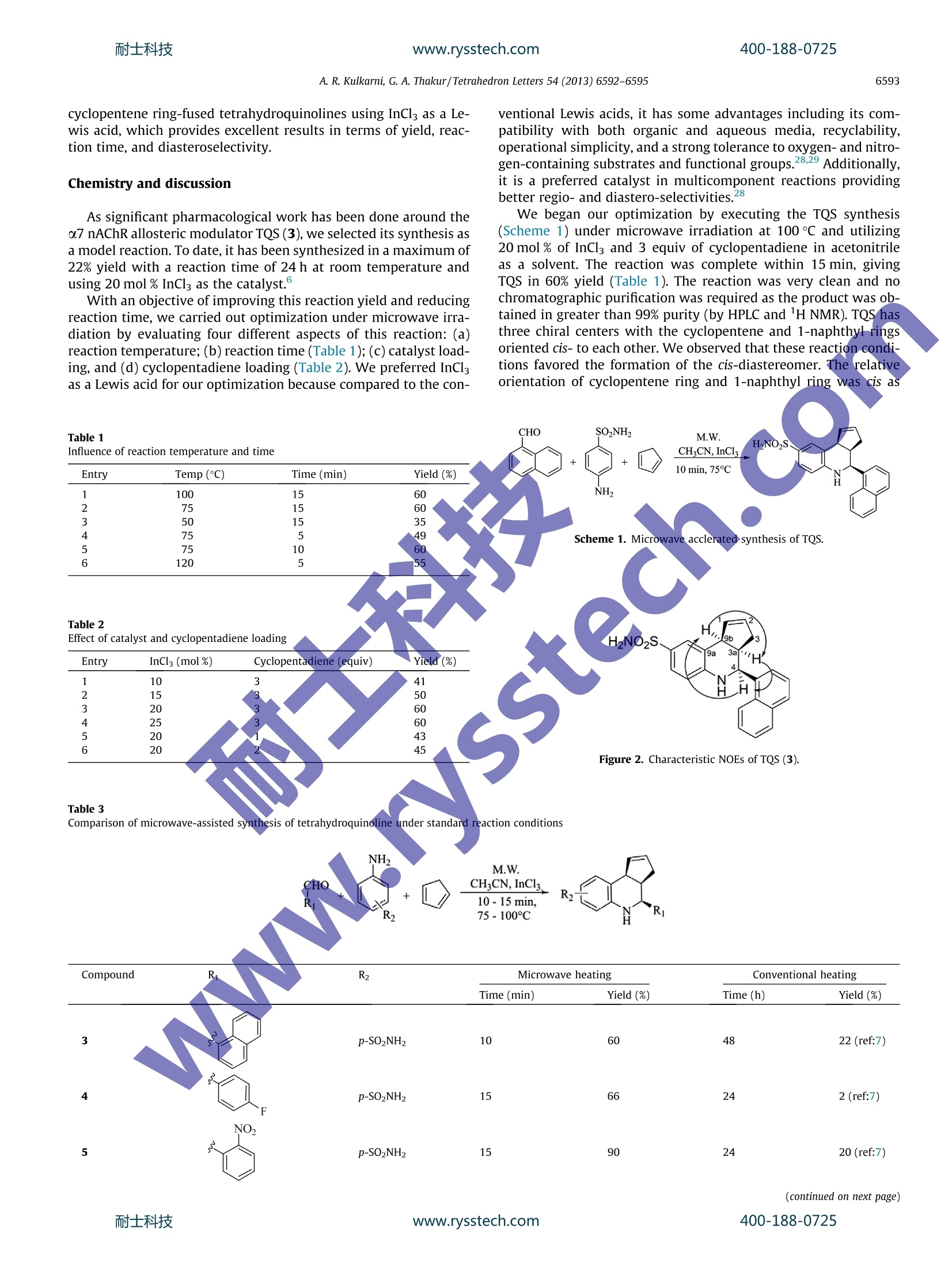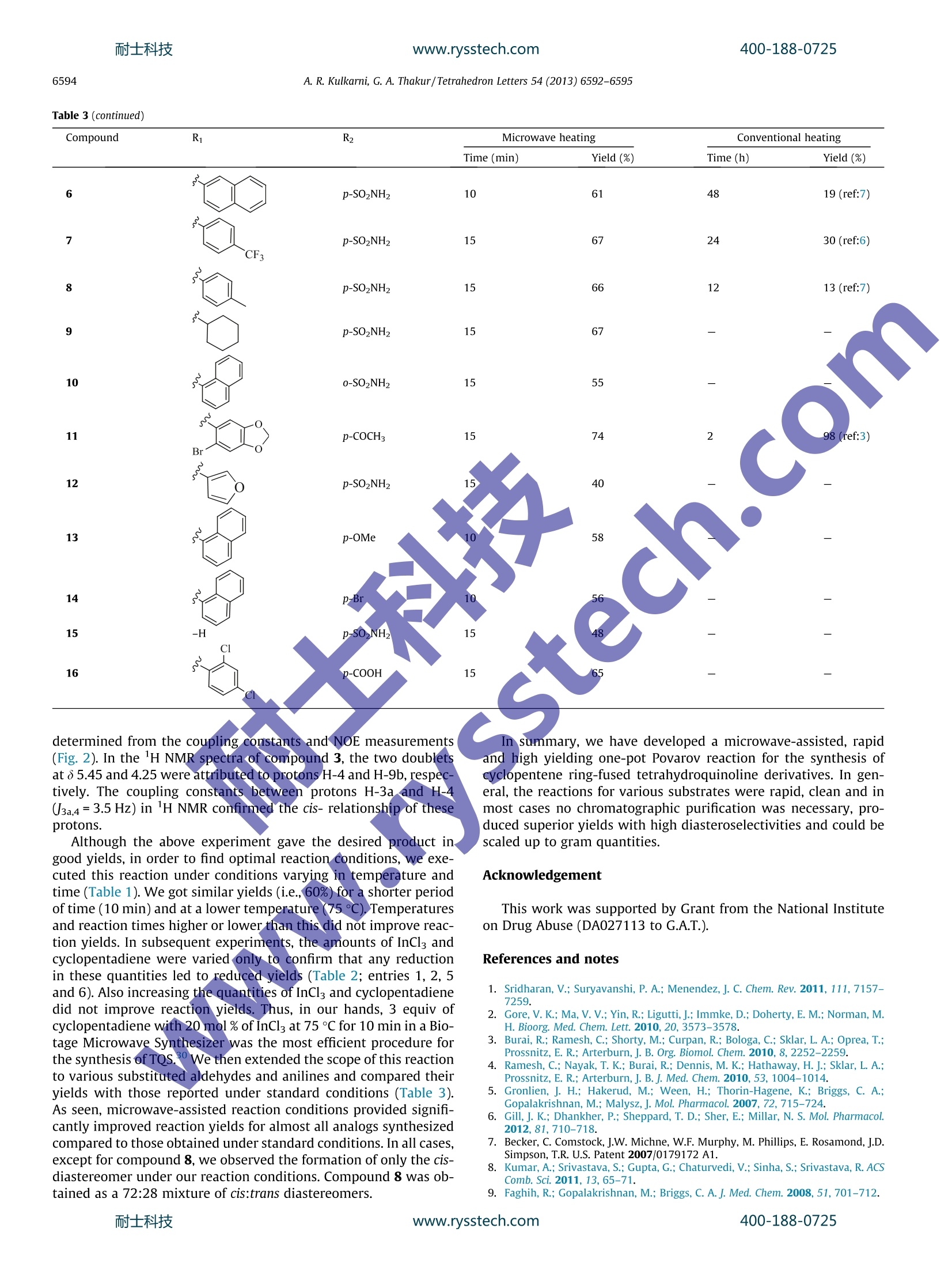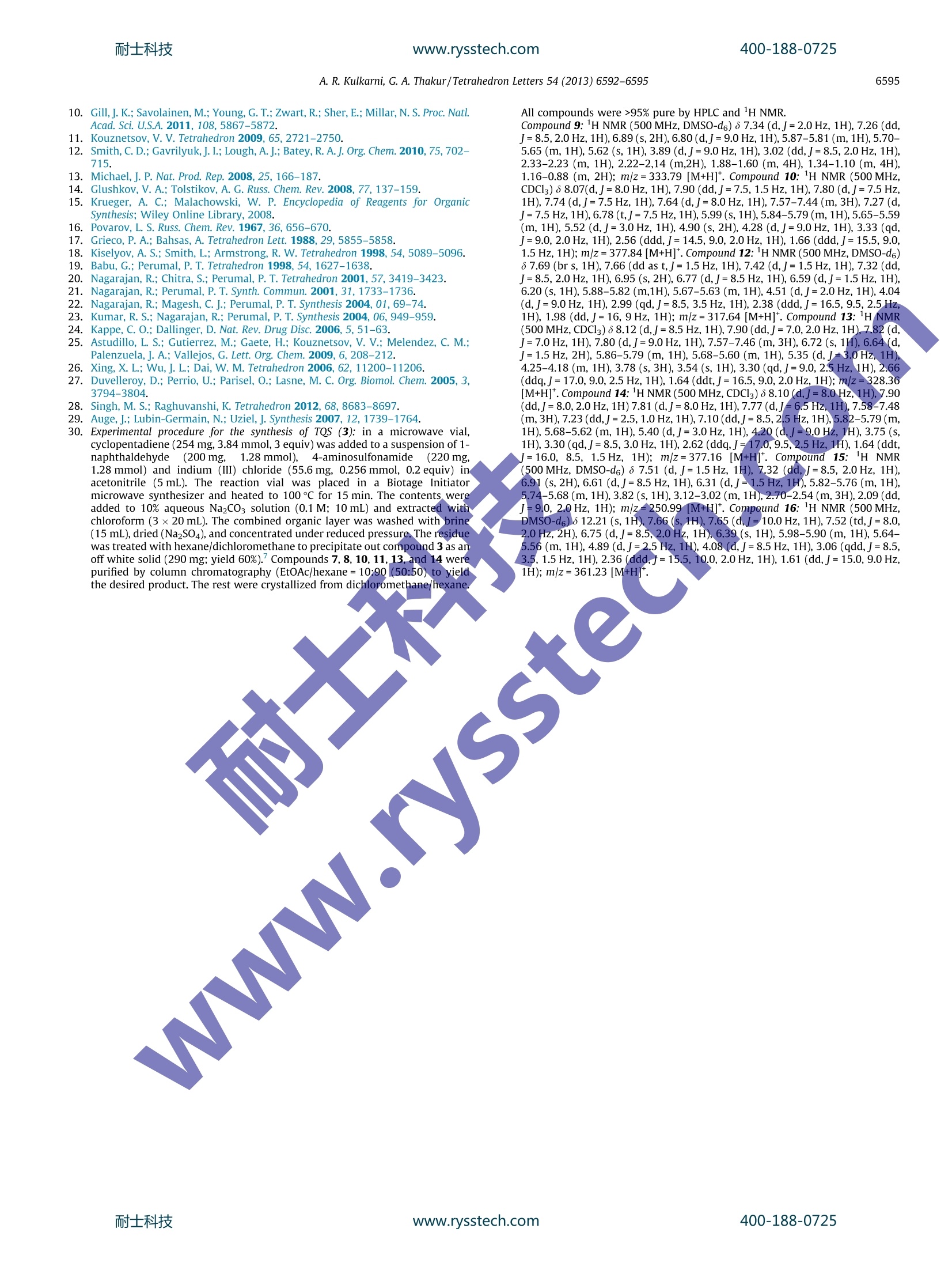
We report here an efficient and expeditious microwave-assisted synthesis of cyclopentadiene ring-fused tetrahydroquinolines using the three-component Povarov reaction catalyzed by indium (III) chloride. This method has an advantage of shorter reaction time (10–15 min) with high and reproducible yields (up to 90%) and is suitable for parallel library synthesis. The optimization process is reported and the results from the microwave route are compared with those of the conventional synthetic route. In almost all cases, the microwave acceleration consistently provided improved yields favoring the cis-diastereomer.
方案详情

耐士科技400-188-0725www.rysstech.comTetrahedron Letters 54 (2013)6592-6595 Contents lists available at ScienceDirect Tetrahedron Letters ELSEVIER journal homepage: www.elsevier.com/locate/tetlet Microwave-assisted expeditious and efficient synthesis ofcyclopentene ring-fused tetrahydroquinoline derivatives usingthree-component Povarov reaction Abhijit R. Kulkarni, Ganesh A. Thakur a.b,* Department of Pharmaceutical Sciences, Bouve College of Pharmacy, Northeastern University, Boston, MA 02115, USACenter for Drug Discovery, Northeastern University, Boston, MA 02115, USA ARTICLEINFO A BSTRACT Article history:Received 5 September 2013Revised 19 September 2013Accepted 21 September 2013Available online 27 September 2013 Keywords:TetrahydroquinolinesNicotinic Acetylcholine ReceptorsMicrowave-assisted synthesisAllosteric ModulatorsPovarov reaction The tetrahydroquinoline derivatives have attracted consider-able attention because of their important biological activities andoccurrence in natural products.Those containing fused cyclopen-tene ring have been found to exhibit a variety of pharmacologicalactivities like agonism at BKCa receptor (1), GPR30 estrogenreceptor(2),34 and allosteric modulation at the o7 nicotinic acetyl-,choline receptors (nAChRs)5-as well as anti-tubercular activityagainst Mycobacterium tuberculosis (Fig.1)One such representa-tive tetrahydroquinoline derivative is TQS (3: 4-(1-naphthyl)-3a,4,5,9b-tetrahydro-3H-cyclopenta[c]quinoline-8-sulfonamide),apotent type I positive allosteric modulator (PAM) of a7 nAC-hRs.79.5.10 Such type II PAMs have been preclinically shown to beuseful in improving memory, cognition and in treating neuropathicpain. Therefore, synthesis of new tetrahydroquinolines still holdsgreat interest.A variety of synthetic methods have been devel-oped for constructing such tetrahydroquinolines and among themthe three-component Povarov reaction has been most empoweringand versatile.12,11,1,13 This reaction which is also known as the aza-Diels Alder reaction can be carried out in a one-pot fashion usingan aniline, an aldehyde, and an electron-rich dienophile in thepresence of various Bronsted as well as Lewis acids. 11,14 Although ( * C orresponding author. Tel.: +1 617 373 8163; fax: +1 617 373 8886. E-mail address: g.t h a k ur@ne u .edu ( G .A. Thakur). ) Figure 1.Representative biologically-active cyclopentene ring-fused tetrahydro-quinolines. the original Povarov reaction was carried out with cyclopentadieneas a dienophile, most of the later optimization and scope expansionof this reaction was focused on shelf-stable dienophiles such aspyran, furan etc.14,11 Synthesis of cyclopentene ring-fused tetrahy-droquinolines has been relatively low yielding7.6.14.11 due to ther-mal instability of cyclopentadiene leading to its spontaneousdimerization at room temperature and gradual polymerizationeven at low temperatures.Various Bronsted and Lewis acids havebeen utilized to accelerate and improve reaction times, but haveled to only limited success.16-21,2.22.23 Microwave-assisted organicsynthesis has become an important tool in organic synthesis forrate enhancement, improving reaction yields, and reducing ther-mal degradation byproducts.24 To the best of our knowledge useof microwave acceleration for the Povarov reaction has been lim-itedtothermally-stableeN-vinylpyrrolidin-2-one,25pyran,26furan,26 2-methoxyacrylate, and acrylamides dienophiles. Inview of this, we report here a microwave-assisted synthesis of cyclopentene ring-fused tetrahydroquinolines using InCl as a Le-wis acid, which provides excellent results in terms of yield, reac-tion time, and diasteroselectivity. Chemistry and discussion As significant pharmacological work has been done around theo7 nAChR allosteric modulator TQS (3), we selected its synthesis asa model reaction. To date, it has been synthesized in a maximum of22% yield with a reaction time of 24 h at room temperature andusing 20 mol % InCls as the catalyst. With an objective of improving this reaction yield and reducingreaction time, we carried out optimization under microwave irra-diation by evaluating four different aspects of this reaction: (a)reaction temperature; (b) reaction time (Table 1); (c) catalyst load-ing, and (d) cyclopentadiene loading (Table2). We preferred InClsas a Lewis acid for our optimization because compared to the con- ventional Lewis acids, it has some advantages including its com-patibility with both organic and aqueous media, recyclability,operational simplicity, and a strong tolerance to oxygen- and nitro-gen-containing substrates and functional groups.28.29 Additionally,it is a preferred catalyst in multicomponent reactions providingbetter regio- and diastero-selectivities.8 We began our optimization by executing the TQS synthesis(Scheme 1) under microwave irradiation at 100℃ and utilizing20 mol% of InCls and 3 equiv of cyclopentadiene in acetonitrileas a solvent. The reaction was complete within 15 min, givingTQS in 60% yield (Table 1). The reaction was very clean and nochromatographic purification was required as the product was ob-tained in greater than 99% purity (by HPLC and HNMR). TQS hasthree chiral centers with the cyclopentene and 1-naphthyl ringsoriented cis- to each other. We observed that these reaction condi-tions favored the formation of the cis-diastereomer. The relativeorientation of cyclopentene ring and 1-naphthyl ring was cis as Table 1Influence of reaction temperature and time Entry Temp (C) Time (min) Yield (%) 1 100 15 60 2 75 15 60 3 50 15 35 4 75 5 5 75 10 6 120 5 Scheme 1. Microwave acclerated synthesis of TQS. Table 2Effect of catalyst and cyclopentadiene loading Entry InCls (mol%) Cyclopentadiene (equiv) Yield(%) 1 10 3 41 2 15 3 20 4 25 5 20 6 20 Figure 2. Characteristic NOEs of TQS (3). Table 3 Comparison of microwave-assisted synthesis of tetrahydroquinoline under standard reaction conditions Compound Microwave heating Conventional heatingTime (min) Yield (%) Time (h) Yield (%) 3 p-SO2NH2 10 60 48 22 (ref:7) 4 p-SO2NH2 15 66 24 2 (ref:7) 0, 5 p-SO2NH2 15 90 24 20 (ref:7) Table 3 (continued) Compound R1 R2 Microwave heating Time (min) Yield (%) Conventional heating Time (h) Yield (%) 6 p-SO2NH2 10 61 48 19 (ref:7) 7 CF3 p-SO2NH2 15 67 24 30 (ref:6) 8 p-SO2NH2 15 66 12 13 (ref:7) 9 p-SO2NH2 15 67 10 0-SO2NH2 15 55 一 11 Br 0 p-COCH 15 74 2 12 p-SO2NH2 心 65 13 p-OMe 14 p-Br Cl 15 -H 2-SO NH, 16 p-COOH 15 determined from the coupling constants and NOE measurements(Fig. 2). In the lH NMR spectra of compound 3, the two doubletsat 8 5.45 and 4.25 were attributed to protons H-4 and H-9b,respec-tively. The coupling constants between protons H-3a and H-4(3a4=3.5 Hz) in 'H NMR confirmed the cis- relationship of theseprotons. Although the above experiment gave the desired product ingood yields, in order to find optimal reaction conditions, we exe-cuted this reaction under conditions varying in temperature andtime (Table 1). We got similar yields (i.e.,60%) for a shorter periodof time (10 min) and at a lower temperature (75C). Temperaturesand reaction times higher or lower than this did not improve reac-tion yields. In subsequent experiments,the amounts of InCls andcyclopentadiene were varied only to confirm that any reductionin these quantities led to reduced yields (Table 2; entries 1, 2, 5and 6). Also increasing the quantities of InCl3 and cyclopentadienedid not improve reaction yields. Thus, in our hands, 3 equiv ofcyclopentadiene with 20 mol % of InCls at 75 ℃ for 10 min in a Bio-tage Microwave Synthesizer was the most efficient procedure forthe synthesis of TQS. We then extended the scope of this reactionto various substituted aldehydes and anilines and compared theiryields with those reported under standard conditions (Table 3).As seen, microwave-assisted reaction conditions provided signifi-cantly improved reaction yields for almost all analogs synthesizedcompared to those obtained under standard conditions. In all cases,except for compound 8, we observed the formation of only the cis-diastereomer under our reaction conditions. Compound 8 was ob-tained as a 72:28 mixture of cis:trans diastereomers. In summary, we have developed a microwave-assisted, rapidandl high yielding one-pot Povarov reaction for the synthesis ofcyclopentene ring-fused tetrahydroquinoline derivatives. In gen-eral, the reactions for various substrates were rapid, clean and inmost cases no chromatographic purification was necessary, pro-duced superior yields with high diasteroselectivities and could bescaled up to gram quantities. Acknowledgement This work was supported by Grant from the National Instituteon Drug Abuse (DA027113 to G.A.T.). References and notes 1. Sridharan, V.; Suryavanshi, P. A.; Menendez, J. C. Chem. Rev. 2011, 111,7157-7259. 2..Gore, V. K.; Ma,V. V.; Yin, R.; Ligutti, J.; Immke, D.; Doherty, E. M.; Norman, M.H. Bioorg. Med. Chem. Lett. 2010, 20,3573-3578. 3..Burai, R.; Ramesh, C.; Shorty, M.; Curpan, R.; Bologa, C.; Sklar, L. A.; Oprea, T.; Prossnitz, E. R.; Arterburn, J. B. Org. Biomol. Chem.2010,8,2252-2259.4.Ramesh, C.; Nayak, T. K.; Burai, R.; Dennis, M. K.; Hathaway, H. J; Sklar, L. A.;Prossnitz, E. R.; Arterburn, J. B. J.Med.Chem. 2010, 53,1004-1014. 5..Gronlien, J. H.; Hakerud, M.; Ween, H.; Thorin-Hagene, K.; Briggs, C. A.;Gopalakrishnan, M.; Malysz, J. Mol. Pharmacol. 2007,72,715-724. 6... Gill, J.K.; Dhankher, P.; Sheppard, T. D.; Sher, E.; Millar, N. S. Mol. Pharmacol.2012,81,710-718. 7. Becker, C. Comstock,J.W. Michne, W.F. Murphy, M. Phillips, E. Rosamond,J.D.Simpson, T.R. U.S. Patent 2007/0179172 A1. 8.Kumar,A.; Srivastava, S.; Gupta, G.; Chaturvedi,V.; Sinha, S.; Srivastava, R. ACSComb. Sci. 2011, 13, 65-71. 9.. Faghih,R.; Gopalakrishnan,M.; Briggs, C. A. J. Med. Chem. 2008,51,701-712. ( 10. G ill, J. K . ; Savo l ainen,M.; Young , G. T.; Z w art,R.; Sh e r, E.; Mil l ar , N. S. Proc. Natl. Acad. Sci . U.S.A. 201 1 , 10 8 ,5867-5872. 11. K ouzne t sov, V . V. Te t rahedro n 2009 , 65,2721-2750. ) ( 12. S mith , C. D.; G a vrily u k, J. I . ; L ough, A. J . ; B atey, R. A . J. Org. Chem. 2010, 75,702- 715. ) ( 13 3. M ichael, J . P. Nat . Prod . Rep.2008,25,1 6 6 -187. ) 14.Glushkov, V. A.; Tolstikov, A. G. Russ. Chem. Rev. 2008,77,137-159. ( 15. K rueger, A . C .; M a l ach o wski , W. P. E nc y clopedia of R ea g ents for Organic Sy nthesis; Wil e y O n line L ibrary, 20 08. ) Povarov, L. S. Russ. Chem. Rev. 1967,36,656-670.16.Grieco, P. A.; Bahsas, A. Tetrahedron Lett. 1988,29,5855-5858. 18. Kiselyov, A. S.; Smith,L.; Armstrong, R. W. Tetrahedron 1998,54,5089-5096. ( 19 .B abu, G.; Peruma l , P . T. Tetrahedron 1998, 54, 1 627-1638. ) ( 20. N agarajan,R.; Chitra, S.; Perumal, P.T. Tetrahedron 2001,57,3419-34 2 3. ) ( 21. N agarajan, R . ; Pe r umal, P . T . Synth . Commun. 2001, 31,1 7 33-1 7 3 6 . ) ( 22. N agarajan, R . ; M agesh, C. J ; P erumal, P . T. Synthesis 2004, 01,69- 7 4. ) ( 23 5 . . K umar, R . S .; N agarajan, R . ; Perumal, P . T. Synthesi s 2004 , 06, 949-959. ) ( 24. K ap p e, C . O . ; D a llinger, D. Nat. Rev . Drug Dis c . 2006, 5 ,5 1 - 6 3 . ) ( 25 . A studil l o, L . S.; Gutierrez, M.; Gaete, H.; Kouzn e tsov, V . V .; M elend e z , C. M . ; P alenzuela, J. A.; Vall e jos, G. Lett . Org . Chem. 2009, 6, 2 08-212. ) ( X ing, X . L .; Wu, J. L.; Da i , W . M . T e trahedro n 2006 , 62, 11 200- 1 120 6 . ) ( 29. D u v elleroy, D . ; P e rrio, U . ; Parisel,O . ; L a sne, M . C. O r g. B i omol. Ch e m. 200 5 , 3, 3794-3804. ) ( 28. Singh, M. S.; Raghuvans h i, K. Tetrahedr o n 2012,68,8683 - 8697. ) 29.Auge,J; Lubin-Germain, N.; Uziel, J. Synthesis 2007,12,1739-1764. 30. E1xperimental procedure for the synthesis of TQS (3): in a microwave vial, cyclopentadiene (254 mg, 3.84 mmol, 3 equiv) was added to a suspension of 1-naphthaldehydee(200mg, 1.28 mmol), 4-aminosulfonamide(220mg,1.28 mmol) and indium (II) chloride (55.6 mg, 0.256 mmol, 0.2 equiv) inacetonitrile (5 mL). The reaction vial was placed in a Biotage Initiatormicrowave synthesizer and heated to 100°C for 15 min. The contents wereadded to 10% aqueous Na2CO3 solution (0.1M; 10 mL) and extracted withchloroform (3×20 mL). The combined organic layer was washed with brine(15 mL), dried (Na2SO4), and concentrated under reduced pressure. The residuewas treated with hexane/dichloromethane to precipitate out compound 3 as anoff white solid (290 mg; yield 60%).'Compounds 7, 8, 10, 11, 13, and 14 werepurified by column chromatography (EtOAc/hexane=10:90(50:50) to yieldthe desired product. The rest were crystallized from dichloromethane/hexane. All compounds were >95% pure by HPLC and 'HNMR.Compound 9: H NMR (500MHz, DMSO-d6)8 7.34 (d,J=2.0Hz, 1H), 7.26 (dd,J=8.5,2.0 Hz, 1H), 6.89(s,2H), 6.80(d,J=9.0 Hz, 1H), 5.87-5.81(m,1H),5.70-5.65 (m, 1H), 5.62 (s, 1H), 3.89 (d,J=9.0Hz, 1H), 3.02 (dd,J=8.5,2.0 Hz,1H),2.33-2.23 (m, 1H), 2.22-2,14 (m,2H), 1.88-1.60(m, 4H), 1.34-1.10 (m, 4H),1.16-0.88 (m, 2H); mjz=333.79 [M+H]*. Compound 10: H NMR (500 MHz,CDCl3) 8 8.07(d,J=8.0Hz, 1H), 7.90 (dd,J=7.5, 1.5 Hz, 1H), 7.80 (d,J=7.5 Hz,1H), 7.74(d,J=7.5Hz, 1H), 7.64 (d,J=8.0 Hz, 1H), 7.57-7.44 (m, 3H), 7.27 (d,J=7.5 Hz, 1H), 6.78 (t,J=7.5 Hz, 1H), 5.99 (s, 1H), 5.84-5.79(m,1H),5.65-5.59(m, 1H), 5.52 (d,J=3.0Hz, 1H), 4.90 (s, 2H), 4.28 (d,J=9.0Hz, 1H), 3.33 (qd,J=9.0, 2.0 Hz, 1H), 2.56 (ddd,J=14.5, 9.0, 2.0 Hz, 1H), 1.66 (ddd,J=15.5, 9.0,1.5 Hz, 1H); m/z=377.84 [M+H]*. Compound 12: HNMR(500 MHz, DMSO-d6)8 7.69 (br s, 1H), 7.66 (dd as t, J=1.5 Hz, 1H), 7.42 (d,J=1.5 Hz, 1H), 7.32 (dd,J=8.5, 2.0Hz, 1H), 6.95 (S, 2H), 6.77(d,J=8.5 Hz, 1H), 6.59(d,J=1.5 Hz,1H),6.20 (s, 1H), 5.88-5.82(m,1H), 5.67-5.63(m, 1H), 4.51(d,J=2.0 Hz, 1H), 4.04(d,J=9.0Hz, 1H), 2.99 (qd,J=8.5, 3.5 Hz, 1H), 2.38 (ddd,J=16.5, 9.5, 2.5 Hz,1H), 1.98 (dd,J=16, 9Hz, 1H); mjz=317.64 [M+H]*. Compound 13: H NMR(500MHz,CDCl3)88.12(d,J=8.5 Hz, 1H), 7.90 (dd,J=7.0,2.0 Hz, 1H), 7.82 (d,J=7.0Hz, 1H), 7.80 (d,J=9.0 Hz, 1H), 7.57-7.46 (m, 3H), 6.72 (s, 1H),6.64 (d,J=1.5 Hz, 2H), 5.86-5.79 (m, 1H), 5.68-5.60 (m, 1H), 5.35 (d,J=3.0Hz, 1H)4.25-4.18(m,1H), 3.78 (s, 3H), 3.54(s, 1H),3.30(qd,J=9.0,2.5 Hz,1H), 2.66(ddq,J=17.0,9.0, 2.5 Hz, 1H), 1.64 (ddt,J=16.5,9.0, 2.0 Hz, 1H); m|z=328.36[M+H]*. Compound 14: 1H NMR(500 MHz, CDCl3) 8 8.10 (d,J=8.0 Hz,1H), 7.90(dd,J=8.0,2.0 Hz, 1H) 7.81(d,J=8.0 Hz, 1H), 7.77 (d,J=6.5 Hz,1H),7.58-7.48(m,3H), 7.23 (dd,J=2.5,1.0 Hz, 1H), 7.10(dd,J=8.5,2.5Hz,1H),5.82-5.79(m,1H), 5.68-5.62(m, 1H),5.40 (d,J=3.0 Hz, 1H),4.20 (d,J=9.0 Hz, 1H), 3.75 (s,1H), 3.30(qd,J=8.5,3.0 Hz, 1H), 2.62(ddq,J=17.0,9.5, 2.5 Hz, 1H), 1.64 (ddt,J=16.0, 8.5, 1.5 Hz, 1H); mjz=377.16 [M+H]t. Compound 15: H NMR(500MHz, DMSO-d6)8 7.51 (d,J=1.5 Hz, 1H), 7.32 (dd,J=8.5, 2.0 Hz, 1H),6.91 (s, 2H), 6.61 (d,J=8.5 Hz, 1H), 6.31 (d,J=1.5Hz,1H), 5.82-5.76 (m, 1H),5.74-5.68(m, 1H),3.82 (s, 1H), 3.12-3.02(m, 1H), 2.70-2.54(m,3H), 2.09 (dd,.=J9.0,2.0Hz, 1H); m|z=250.99[M+H]*. Compound 16: 'H NMR (500MHz,DMSO-d68 12.21 (s, 1H), 7.66 (s, 1H), 7.65(dJ-=10.0Hz,1H), 7.52 (td,J=8.0,2.0 Hz, 2H), 6.75 (d,J=8.5, 2.0 Hz,1H), 6.39 (s, 1H), 5.98-5.90 (m, 1H), 5.64-5.56 (m, 1H), 4.89 (d,J=2.5 Hz, 1H), 4.08(d,J=8.5 Hz, 1H), 3.06 (qdd,J=8.5,3.5, 1.5 Hz, 1H), 2.36(ddd,j=15.5, 10.0, 2.0 Hz, 1H), 1.61 (dd,J=15.0, 9.0Hz, $-see front matter @ Elsevier Ltd.All rights reserved.http://dx.doi.org/j.tetlet.ww.rysstech.com耐士科技 (continued on next page)耐士科技www.rysstech.com
确定




还剩2页未读,是否继续阅读?
上海鑫欣生物科技有限公司为您提供《化学药中特殊物质和基团检测方案 》,该方案主要用于化药新药研发中其他检测,参考标准--,《化学药中特殊物质和基团检测方案 》用到的仪器有
相关方案
更多
该厂商其他方案
更多









